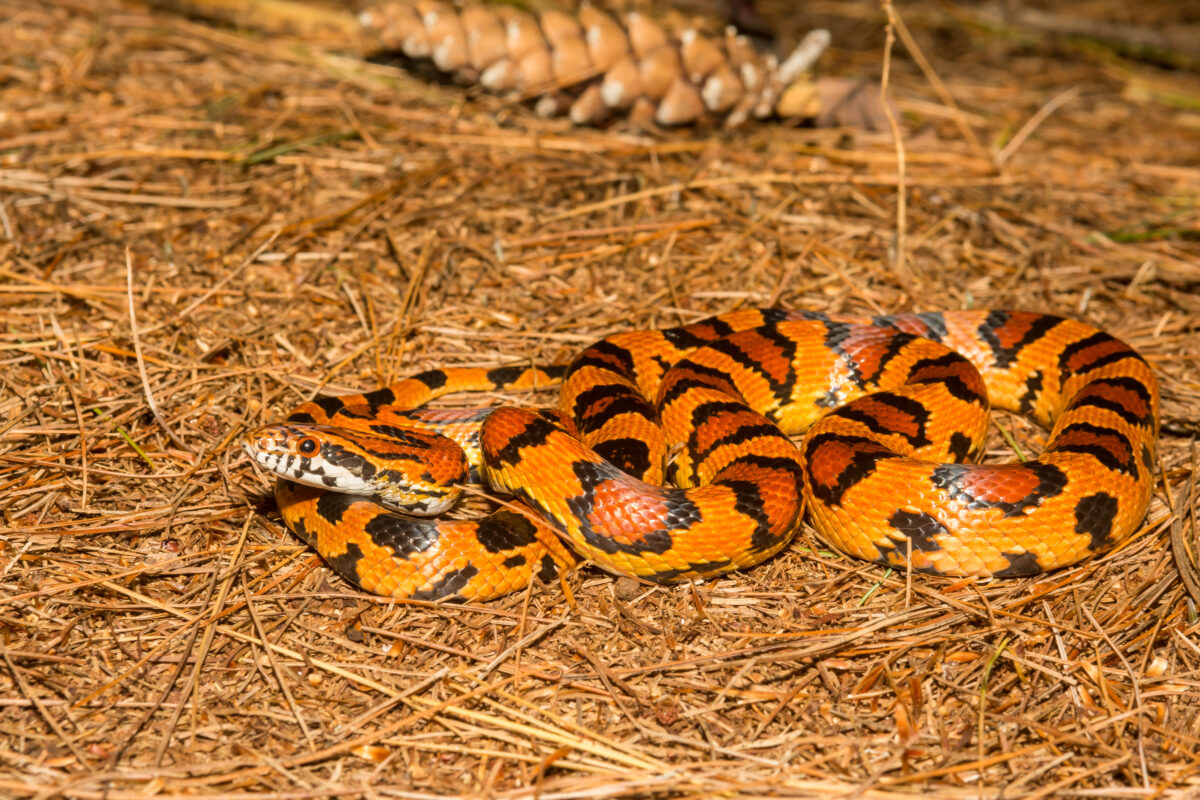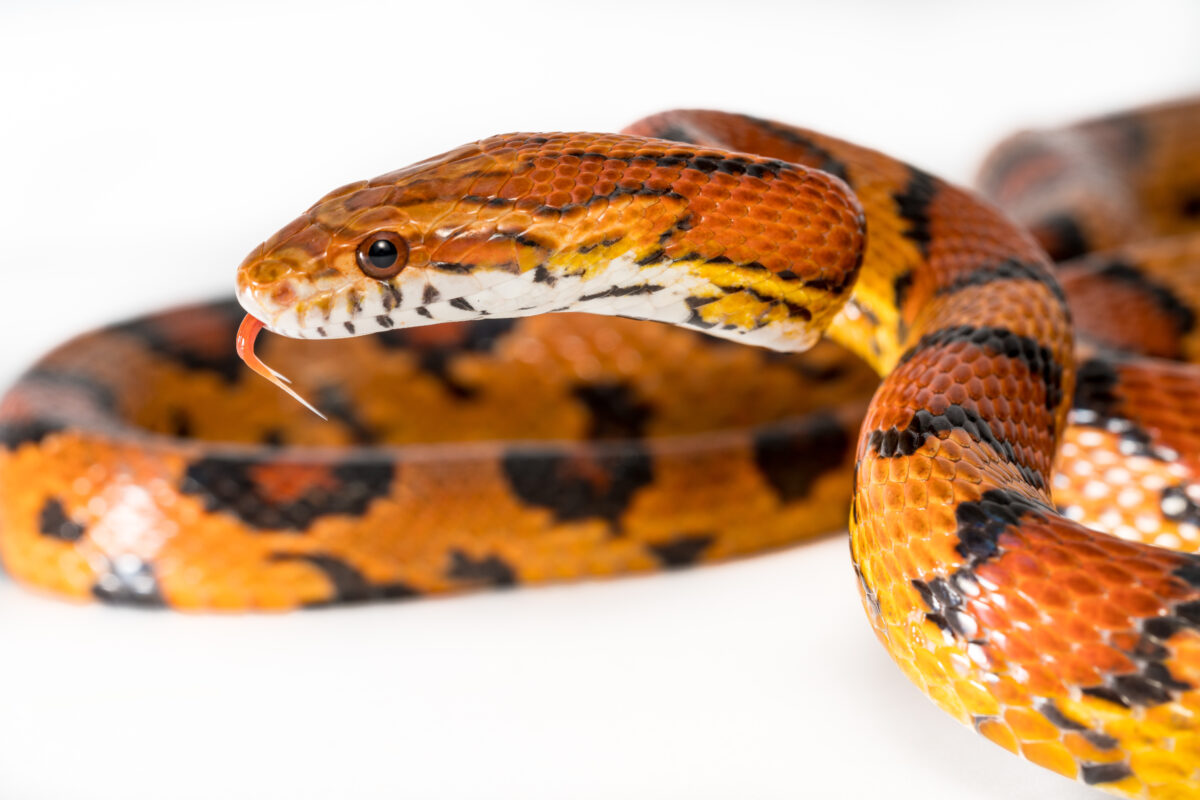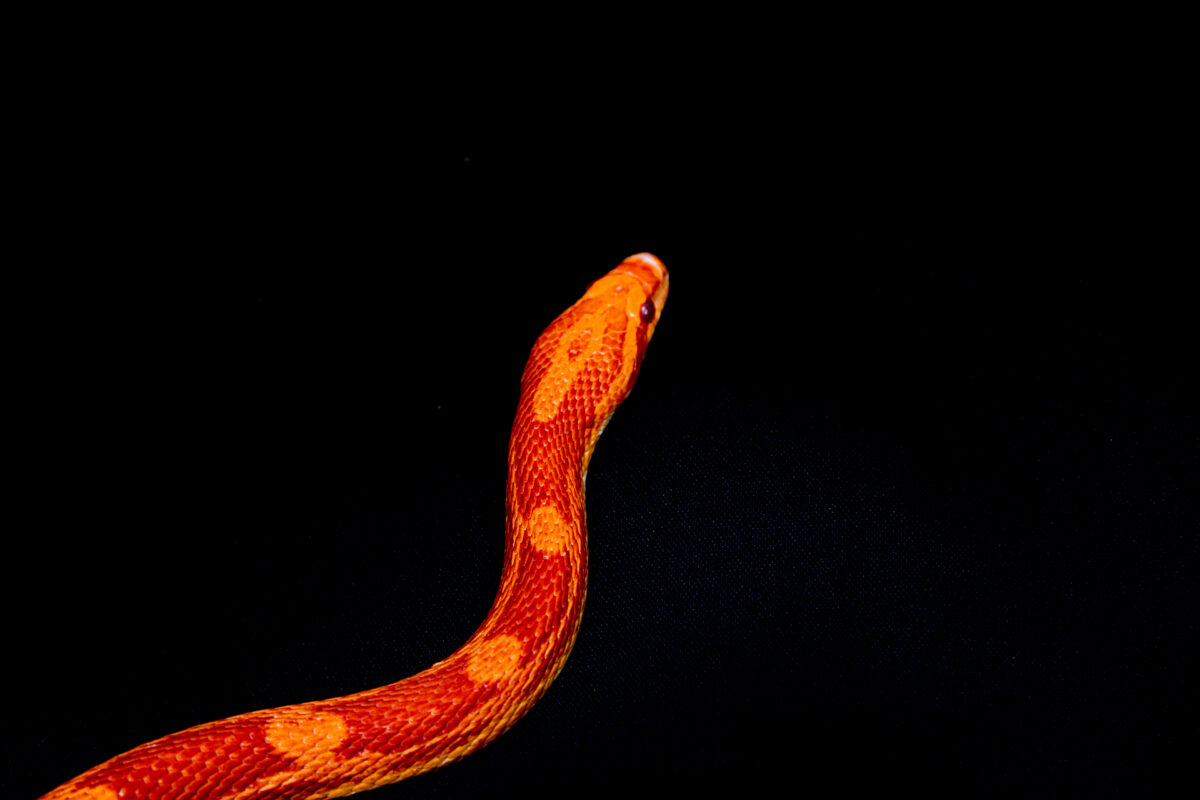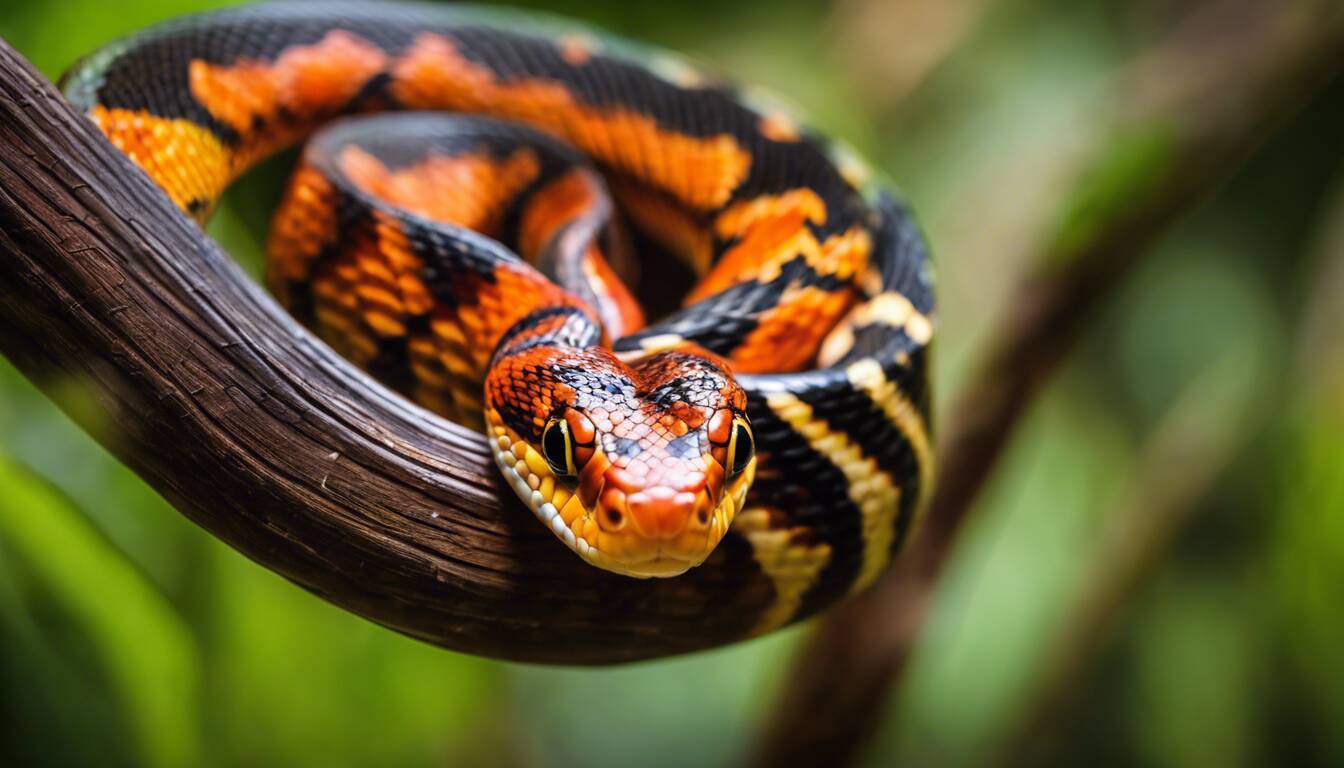Caring for an Okeetee Corn Snake presents an intriguing task. The snake’s radiant red-orange saddles with black borders, the result of meticulous selective breeding, reveal an incomparable beauty. However, the secret twist is their longevity; when well-cared for they may live for over twenty years. Now let’s look closer into their captivating color and pattern.
Okeetee corn snakes are known for their distinct red-orange saddles bordered by black borders along their back, making them visually striking reptiles. They are relatively easy to care for and have a docile temperament, making them ideal for beginner snake enthusiasts. If you’re considering a pet snake, be sure to provide proper housing, temperature, and humidity conditions for the health and well-being of Okeetee corn snakes.
Traits of Okeetee Corn Snakes: Color, Pattern, Size and Lifespan
One of the most striking features of Okeetee corn snakes is their vibrant coloration. They are known for their reddish-orange hue with distinct black-bordered red saddle markings along their back. These patterns give them a unique and eye-catching appearance, setting them apart from other morphs of corn snakes.
The saddle-shaped blotches along their backs create a visually stunning contrast with the rest of their body, making these snakes truly stand out. As breeders have selectively worked to enhance these distinctive color patterns, Okeetee corn snakes have become highly sought after due to their captivating appearance. Whether it’s the red-orange backdrop or the sleek black borders that define their scales, these snakes leave a lasting impression on anyone fortunate enough to behold them.
Size and Lifespan
In addition to their captivating color and pattern, Okeetee corn snakes also boast a moderate size that makes them manageable for owners. While adults typically range from 3 to 5 feet in length, they maintain a slender profile that’s both elegant and convenient in a captive environment. Their relatively compact size makes them well-suited for captivity while still offering an impressive physical presence. Furthermore, these remarkable animals have a lifespan of 15 to 20 years in captivity when provided with proper care and living conditions. This means that these snakes can be lifelong companions for those who are committed to offering them the care and attention they require.
By understanding the intricate details of their color, pattern, size, and lifespan, you gain deeper insight into what makes Okeetee corn snakes such remarkable creatures. Their striking appearance and manageable size, combined with their potential for long-term companionship, make them truly special additions to any reptile enthusiast’s collection.
As we’ve marveled at the distinct features and potential lifelong bond with Okeetee corn snakes, now let’s explore how to create an ideal environment for these fascinating reptiles in your home.
See Related: Lavender Albino Corn Snake Care: A Complete Guide for Reptile Lovers
Creating an Ideal Environment: Setup, Heating, Lighting, and Hides

When setting up the perfect environment for your Okeetee corn snake, several key elements need to be considered. The enclosure setup, heating, lighting, and providing adequate hiding spots are crucial in ensuring your snake feels safe and comfortable.
Enclosure Setup
Your snake’s habitat should resemble a cozy home where they can live happily. It should be spacious enough for them to move around and explore. Providing escape-proof and well-ventilated enclosures is essential to keep your snake secure and healthy. Additionally, including suitable substrate for burrowing and climbing opportunities allows them to exhibit their natural behaviors.
Heating and Lighting
Maintaining the right temperature within the enclosure is vital to ensure your Okeetee corn snake stays healthy. They require a warm side of the enclosure, with temperatures ranging around 85-88°F, and a cooler side at about 70-75°F. This temperature gradient allows them to move between different temperature zones based on their needs. In addition, mimicking a natural light-dark cycle in their environment is crucial to replicate their natural habitat. This helps regulate their internal body clock and ensures overall well-being.
Hides
Multiple hiding spots in the enclosure are critical in alleviating stress and making your snake feel secure. These hiding spots can be in the form of commercial hides or natural objects such as driftwood or cork bark. Providing a variety of hiding places allows your snake to choose areas that suit their comfort, reducing stress levels and promoting a sense of security.
Understanding these key elements of creating a suitable environment for your Okeetee corn snake is crucial in ensuring they remain healthy and happy in captivity. By paying attention to these details, you provide your snake with the best possible living conditions, enabling them to thrive in their new home.
See Related: How Many Eggs Does a Snake Lay? A Guide to Snake Reproduction
Understanding a Balanced Diet for Okeetee Corn Snakes

Feeding your Okeetee corn snake is an important aspect of their care. In the wild, these snakes would have to hunt for their food, mainly small rodents like mice, which is what we usually feed them in captivity. But it’s not just about throwing a mouse in and calling it a day; we need to ensure they’re getting the right amount of food at the right times.
Corn snakes are adept at signaling when they’re hungry by becoming more active and may even stick their tongues out more often. It’s as if they’re saying “Hey, I’m ready for some dinner.” However, just because they want to eat, it doesn’t mean we should satisfy their appetite every time they ask for it.
The Right Portion
We must be cautious not to overfeed or underfeed our snake companions. Offering prey items about the same width as the snake at its widest point ensures they get the right amount of food without overeating or struggling to swallow something too large.
Now, regarding how often they should eat, it depends on their age. Adult Okeetee corn snakes generally eat once every 7-10 days. But younger snakes need more fuel to grow, so they might need to eat more frequently—about once every 4-5 days.
And akin to us, different snakes have different preferences. Some may require meals more often than others, and that’s perfectly fine. The key is to observe your snake’s habits and adjust their feeding schedule accordingly—respecting their individual needs.
It’s natural to want your pet to be content and well-fed, but be cautious about overcompensating with extra meals. Sometimes, well-intentioned pet owners can accidentally overfeed their corn snakes, leading to obesity and health problems.
Feeding your Okeetee corn snake requires a nice balance between meeting their nutritional needs and maintaining a healthy weight.
Overall, providing the right portion size and adhering to a regular feeding schedule will help maintain your snake’s health and vitality, ensuring they thrive in captivity just as they would in the wild.
As we move on from understanding the dietary needs of Okeetee corn snakes, let’s now shift our focus to the delicate art of breeding these fascinating reptiles.
Breeding Okeetee Corn Snakes: Laying, Hatching, and Caring for Hatchlings
Breeding Okeetee corn snakes can be an exciting and rewarding experience for reptile enthusiasts. Understanding the reproductive behavior and requirements of these snakes is crucial for successfully breeding and caring for the hatchlings.
When it comes to breeding, there are some key points to be mindful of. First, ensuring that both the male and female snakes are healthy and at the appropriate age is essential. Females typically reach sexual maturity at around 3 years of age, while males may be ready to mate even earlier. It’s important to observe the behavior and physical development of the snakes to determine their readiness for breeding.
Once you have identified a healthy pair of snakes, creating the ideal environment for mating is critical. This involves providing them with adequate space, suitable temperature gradients, and proper hiding spots within their enclosure. These environmental factors play a crucial role in stimulating the natural breeding instincts of the snakes.
Mating behaviors typically begin with courtship rituals displayed by the male snake, including pheromone trails and physical interactions with the female. Once successful mating has occurred, the female Okeetee corn snake will undergo a gestation period before laying her eggs. It’s essential to monitor her health and provide a stress-free environment during this time to ensure successful egg development.
When it comes to laying eggs, Okeetee corn snakes are prolific breeders, with females capable of laying clutches of up to 15 eggs. This significant clutch size emphasizes the importance of preparing an appropriate incubation setup well in advance. The eggs must be carefully collected, inspected for viability, and placed in a controlled environment with consistent temperature and humidity levels.
The incubation period is crucial for the development of the embryos within the eggs. Maintaining stable temperature conditions between 78-82°F during this period is vital for successful hatching. Additionally, regular monitoring of the eggs and adjustment of environmental conditions as needed is necessary to ensure optimal hatch rates.
Once the eggs have hatched, neonate Okeetee corn snakes require attentive care and feeding to support their growth and development. Providing appropriate housing, temperature gradients, and a well-balanced diet is essential for the health and vitality of the hatchlings as they begin their journey in the world.
In ensuring a nurturing environment for Okeetee corn snakes, attention to detail from breeding through early life stages is paramount. Now, let’s delve into making well-informed decisions when considering Okeetee corn snakes as pets.
Okeetee Corn Snakes as Pets: Making the Right Choice

Choosing a pet, especially an exotic one like an Okeetee corn snake, is a decision that requires thoughtful consideration. Before welcoming these beautiful creatures into your home, it’s crucial to understand what it entails to care for them. Whether you’re new to snake-keeping or an experienced reptile enthusiast, there are important aspects to consider before making the commitment.
Okeetee corn snakes have gained popularity as pets because they are relatively easy to care for and make great companions, particularly for beginners in snake-keeping. Their docile temperament also makes them ideal for handling. Yet, it’s essential to be honest about your ability to provide proper care and attention. While they may be easier to care for than some other snake species, they still require a significant level of commitment and responsibility.
It’s not just a short-term commitment to keep an Okeetee corn snake as a pet—it’s a lifelong dedication. With a lifespan of 15-20 years, adopting one means committing to consistent care throughout its entire lifetime, including ensuring proper housing, temperature, humidity conditions, and suitable diet over the years.
Before welcoming an Okeetee corn snake into your home, assess if you are prepared for this long-term commitment. Consider your lifestyle and future plans. If you anticipate significant changes in the coming years, such as moving to a new residence or starting a family, it’s essential to determine whether you can continue providing the necessary care for your pet through those transitions. Transparency about your ability to meet these long-term requirements is crucial for both you and the well-being of the snake.
Fulfilling their needs takes time and dedication, but building a strong connection with these fascinating creatures can be incredibly rewarding.
So, while Okeetee corn snakes can make wonderful pets under the right circumstances, it’s vital to carefully weigh the commitment involved before deciding to bring one into your home. Always strive to ensure that you can meet their needs and provide the care they require throughout their entire lives.
With careful consideration of the responsibilities involved in caring for an Okeetee corn snake, let’s now shift our focus to understanding potential health issues that may arise amidst these captivating reptiles.
Potential Health Issues Amidst Okeetee Corn Snakes

Just like any other living being, Okeetee corn snakes are susceptible to a range of health concerns that require diligent management and care. These fascinating reptiles can develop several health problems, but with optimal care and attention, many of these issues can be prevented or effectively managed.
Let’s explore some of the common health concerns that Okeetee corn snakes may encounter:
Respiratory Infections
This is one of the most prevalent health issues seen in Okeetee corn snakes, with approximately 15% of them experiencing respiratory infections in their lifetime. These infections often occur due to environmental factors such as inadequate temperature or humidity levels in their enclosures. Symptoms may include wheezing, open-mouth breathing, nasal discharge, and decreased activity.
Regular monitoring of environmental conditions and providing appropriate heating and humidity levels can significantly reduce the risk of respiratory infections in Okeetee corn snakes.
Scale Rot
Around 8% of Okeetee corn snakes are affected by scale rot due to poor husbandry or environmental conditions. Scale rot is a bacterial or fungal infection that affects the scales and skin, leading to discoloration, swelling, or even sloughing off of the affected scales.
Parasitic Infestations
Approximately 20% of Okeetee corn snakes may experience parasitic infestations, such as mites or ticks, especially in captive environments. These tiny parasites can cause irritation, skin damage, and stress to the snake. Regular inspection and proper quarantine procedures for new additions to your snake collection can help prevent parasitic infestations.
Neurological Disorders
Neurological disorders can affect around 5% of Okeetee corn snakes and may manifest as head tilt, seizures, or abnormal movements. These disorders can be linked to genetic factors or environmental stressors. Providing a stress-free environment and ensuring genetic diversity during breeding can help mitigate the risk of neurological disorders.
Digestive Issues
Digestive issues, including regurgitation or constipation, may affect approximately 10% of Okeetee corn snakes. These problems are often related to improper feeding or husbandry practices. Ensuring a balanced diet and creating an optimal environment for digestion is crucial in preventing digestive issues.
In conclusion, understanding these potential health issues alongside proactive veterinary care and diligent husbandry practices will greatly contribute to the overall well-being and longevity of Okeetee corn snakes under your care.
